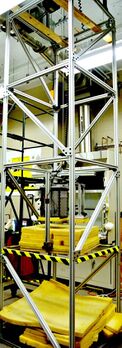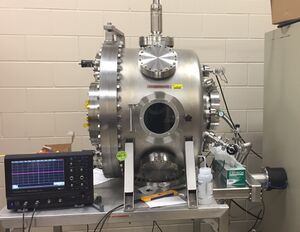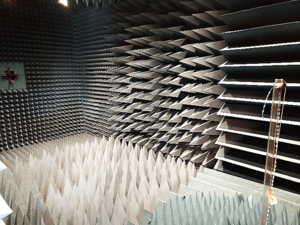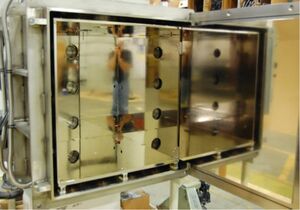Academia Facilities
Academia Facilities
University of Central Florida (UCF)
-
UCF is located in Orlando, Florida
-
Center for Microgravity Research (CMR)
- Equipped for laboratory studies of microgravity dust dynamics processes and the motion and charging of dust grains in vacuum and plasma environments.
- Equipment: Electronics benches for instrument and hardware development, oscilloscopes and electrometers for signal analysis, PPE, fume hood, high-speed video recording
- CMR includes three laboratories of 600 ft2 each.
- POC: Professor Addie Dove
-
Center for Microgravity Research (CMR)
-
Exolith Lab
- Producing high-fidelity mineral-based regolith stimulants.
- POC: Professor Addie Dove
UCF Vacuum Bell Jars
- The CMR has two high-vacuum quality bell jars for use in a variety of dust experiments.
- ~18” ID, 36” useable height
- Ultimate pressure ~ 1 x 10-3 Torr
- The chambers have been used for a large number of dust dynamics experiments.
- Both are equipped with ports for external camera access, and can be reconfigured based on the experiment.
- Both are equipped with the ability to cool samples on the interior via liquid nitrogen feedthrough and cooling jackets.
- One additional bell jar chamber is being outfitted to perform thermal vacuum testing.
- Location: University of Central Florida (UCF) Center for Microgravity Research (CMR)
- POC: Professor Addie Dove

UCF Vacuum Bell Jars

UCF Drop Tower
UCF Drop Tower
- The CMR contains a drop tower that is a 3.4 m high structure
- 0.8 second freefall microgravity time
-
Drag shield can be equipped for cleaner µg
- For experiments requiring high microgravity quality, a drag shield is dropped immediately under the experiment box thus avoiding air drag during the free-fall time, allowing for a 10-4g quality microgravity.
- Experiment volume typically ~10”x10”x12”
- Experiment volume evacuated to ~100 mTorr
- Self-contained experiment controls and recording
-
Automated trigger at drop
- Battery powered, Arduino, high-speed camera w/ buffer
- Location: University of Central Florida (UCF) Center for Microgravity Research (CMR)
- POC: Professor Addie Dove
UCF Plasma Vacuum Chamber
- ~1m3 vacuum chamber
- Large interior volume
- Turbo-roughing pump system to bring the chamber
- Ultimate pressure ~1 x 10-6 Torr
- Electron gun (up to 20keV)
- Motion stages for manipulation, multiple instrumentation
- Many ports for optional sources, instrumentation, data
- Equipped to generate plasma that will be used to simulate a range of plasma conditions, to include an ultraviolet lamp to generate photoelectron emission
- Properly outfitted to allow for inclusion of dust in the chamber
- Location: University of Central Florida (UCF) Center for Microgravity Research (CMR)
- POC: Professor Addie Dove

UCF Plasma Vacuum Chamber
UCF Exolith Lab
- The Exolith Lab is an 1100 sq. ft. warehouse facility at UCF dedicated to producing high-fidelity mineral-based regolith stimulants.
- The lab is equipped with a 10 inch gape gas-powered jaw crusher, chain mills and ball mills, mixers, sieves, and other rock prep tools. With over 10 tons of various raw minerals on hand, customized regolith and other surface materials can be rapidly prototyped to fit any need. Currently, the lab is set up to produce simulated materials based on lunar, martian and asteroidal samples, including a variety of textures from fine regolith to larger cobbles.
-
Several types of regolith simulants are available at the CMR laboratory and UCF.
- These include glass and stainless steel beads for testing and comparison, quartz sand, JSC-1 lunar simulant, JSC-Mars 1 simulant, and a number of simulants being developed through the Center for Lunar and Asteroid Surface Science (CLASS) and the Exolith Lab. This also includes capabilities to sieve and modify simulants, and to create icy mixtures with simulants, as necessary.
- Location: University of Central Florida (UCF) Exolith Lab
- POC: exolithlab@ucf.edu or Professor Addie Dove
Embry Riddle Aeronautical University (ERAU)
-
Wireless Devices and Electromagnetics Laboratory (WiDE)
-
Laboratory capabilities for Lunar Dust-Related Testing
- Anechoic Chamber
- Thermal Vacuum Chamber
- Material Handling – Glove Boxes
-
Material and device level characterization up to 67 GHz
- Keysight PNA (67 GHz) (among other vector network analyzers)
- Cavity resonators and other fixtures for electromagnetic property extraction
- RF Probing
- POC: Eduardo A. Rojas-Nastrucci
-
Laboratory capabilities for Lunar Dust-Related Testing
ERAU Antenna Anechoic Chamber
- ETS AMS-8500 Antenna Anechoic Chamber (0.5-20 GHz)
- 12 ft x 12 ft x 24 ft
- Can be used for testing impact of lunar dust on antennas for EVA suits and other antennas for the lunar surface.
- Heavy duty positioner (100 lb max. payload) for small spacecraft testing.
- Use simulants to replicate accretion on antennas of interest to NASA, inside of an anechoic chamber to emulate a free space environment.
- WiDE Lab
- POC: Eduardo A. Rojas-Nastrucci

ERAU Antenna Anechoic Chamber
ERAU Thermal Vacuum Chamber
- 1x1x1 m3 test area
- Space environment testing:
- Operational vacuum: ≤ 10-6 Torr
- Temperature range: -80°C to +200°C
- Optical, USB, and fiber optic ports
- Currently undergoing commissioning testing
- WiDE Lab
- POC: Eduardo A. Rojas-Nastrucci

ERAU Thermal Vacuum Chamber
ERAU Glove Boxes
- For material handling
- WiDE Lab
- POC: Eduardo A. Rojas-Nastrucci
Additional University Facilities
- Dust Accelerator Lab at University of Colorado
- Ultra High Vacuum Chamber (UHV) & Ice and Gas Target Chambers at U. Colorado
- Reflectance Experiment Lab at Brown University
- Vibrational Spectroscopy Lab at Stony Brook University
- Physical Properties Lab (U. Central Florida)
-
Michigan Tech University
- Lunar Mining and Manufacturing
- Long duration exposure chamber
- POC: Paul Van Susante (pjvansus@mtu.edu)
-
Georgia Tech, Center for Space Technology and Research
- POC: Thom Orlando (Thomas.Orlando@chemistry.gatech.edu)
-
William & Mary College
- POC: Joel Lavine (joelslevine@gmail.com)